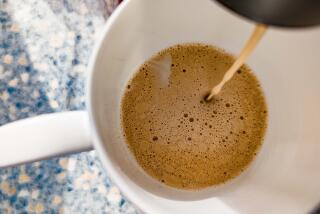Food’s sticker shock: A closer look at drought and crop damage
For many people, a trip to the supermarket has become a perilous journey of navigating aisles of expensive goods and even more expensive goods. And now, it might seem, a villain has been found – weather that has prompted drought conditions and damaged crops in much of the United States.
But today’s higher prices at the grocery store can’t be blamed on current drought conditions. In fact, although the drought could push prices up for consumers on a variety of products, the impact won’t be felt for months or even a year. Further, those prices will depend on a variety of other economic factors. Ultimately, the drought may not lead to a huge increase in prices even then.
On Wednesday, the Department of Agriculture announced that 39 more counties in eight states had been designated as natural disaster areas because of drought and excessive heat. That brings the total during the 2012 crop year to 1,297 counties in 29 states; 61% of the continental United States is in moderate to exceptional drought, according to the government.
The hotter and drier weather has already taken a toll on crops, according to the federal agency. Only 31% of the corn crops in the key states are rated good or excellent, down from about 40% a week earlier. Last year, fully two-thirds of the corn crops were rated good or excellent. Soy beans were down by similar numbers.
“There’s no question that this drought is having an impact on our crops: 78% of the corn crop is now in an area designated as drought-impacted; 77% of the soybeans that are being grown in this country [are] also impacted,” Agriculture Secretary Tom Vilsack said at a briefing for reporters at the White House. “It also obviously involves other commodities as well – 38% of our corn crop as of today is rated poor to very poor, 30% of our soybeans poor to very poor.”
But those figures only indicate the size of the problem in bringing help to drought-stricken farmers. For consumers, none of the drought-related problems have had time to work through to the grocery level, Vilsack said.
“I think the most important thing right now is for consumers to be aware and to keep an eye on it, and begin asking questions -- if they see a dramatic increase in hamburger costs or steak costs -- they should ask, ‘What’s with this?’ And if someone says it’s the drought, they should push back and say, ‘Now, wait a second, that’s not the reason,’” Vilsack told reporters.
Still, people believe that they’re paying more and that they could face even higher prices down the road. The actual data provide both background and explanation.
According to the latest numbers from the Bureau of Labor Statistics, overall food inflation for June was 2.7%, down from 2.8% in May. Compared with last year, inflation for food at home was also down slightly, at 2.6% from 2.7%, in May.
But those optimistic figures don’t account for 2011, which had the second-largest food price increase in decades, jumping 4.8%. Even though food prices have been relatively flat or continued to increase at much smaller rates, that big price jump continued to stay in the system. Such prices are like a car accident being very slowly carted away: Even though the blockage doesn’t get worse, traffic still has problems flowing.
Large commodities, especially protein, have been especially hard-hit by price increases: Beef is up 4% to 5%, for example, and seafood is up 7%.
Couple those rising prices with the general economic worries about not having enough money during a recession and you have an explanation for sticker shock at the market cash register.
But if the drought doesn’t explain the current prices, what of the future?
Food prices follow grain and oilseed prices. The rule of thumb is if the farm price of corn increases 50%, the costs of the consumer retail shopping basket increases by 0.5% to 1%. In general, if the commodity price index increases, then about 10% is passed on to consumers in retail prices.
Still there are other factors at work, such as supply and demand.
Corn futures are up about 30% from early June, meaning the cost of feeding stock has risen so the price of meat is going up, right?
Maybe. Cattle and hog futures have actually declined a bit, because higher feed costs lead some farmers to kill off part of their herds to save money. That brings more meat to market, so prices may drop initially in the short term.
If there will be drought-related price impacts, the areas with jumps will be beef, pork, poultry and dairy, especially milk. Some price increases in those areas could be felt in about two months. The impact of corn price hikes on things like cereal could take 10 to 12 months.
“We would anticipate in the short term actually food prices for beef, poultry, pork may go down a bit, but over time they will rise,” Vilsack said. “We will probably see those higher prices later this year, first part of next year. Processed foods obviously are impacted by crop yields, and we will likely see the increase of that also in 2013.”
ALSO:
FBI dive team will join search for missing Iowa girls
Surprise! Would-be cafe robbers run into tough 71-year-old
Rotten Tomatoes shuts down ‘Batman’ comments after death threats
Join Michael on Google+. Email: [email protected]
More to Read
Sign up for Essential California
The most important California stories and recommendations in your inbox every morning.
You may occasionally receive promotional content from the Los Angeles Times.











